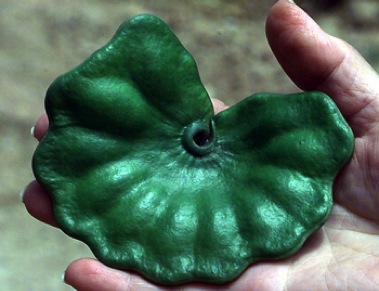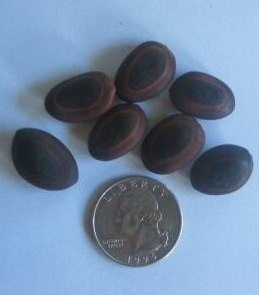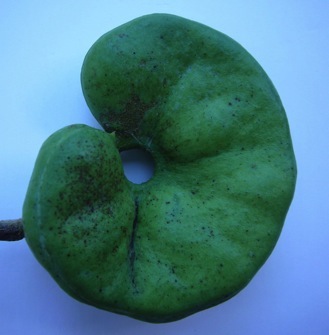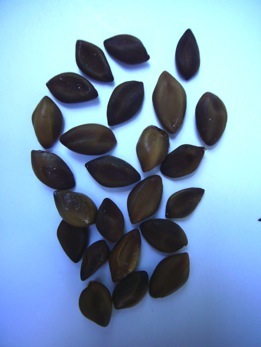Lend Me An Ear Tree
Just about anyone who has spent anytime in a warm climate will some day find on a sidewalk a black seed pod that looks like a human ear…. or a miniature elephant’s ear. That usually leads to seeing a huge shade/food tree that seems to be more appreciated in equatorial countries than others. Here in Florida, where bellies are full, the Ear Tree is a trash tree and rarely tended.
As a southern Greek of northern birth — hence my constant migration southward — the Ear Tree was my second introduction to warms climates after the palms. Ear Trees get more respect the closer one gets to the equator. It’s planted as a shade tree, a source of forage for cattle, and food for humans. It shades coffee trees and fertilizes the soil by fixing nitrogen. Outside of the United States you will find in cherished in parks and designed landscapes like majestic oaks are elsewhere. In the US it is a neglected opportunist often with storm-damaged branches and litter around its base.
That said, there are actually two “ear trees.” One has edible seeds and the other probably not. So far experiments have not been successful. The edible ear tree, Enterolobium cyclocarpum, is pictured above. The questionable ear tree, Enterolobium contortisiliquum, is pictured below right. To tell them apart, look for deep green pods with clearly marked seed pockets, also distinguishable when turned dark. More so, the seeds of the two are different. Round in the known edible, E. cyclocarpum, and pointed in the doubtful edible E. contortisliquum.
The flowers of the E. cyclocarpum (edible) are white and arranged like a spiked ball. The tree blooms February through April. The fruits take three months to ripen. The seeds are ripe when the seed pod (pericarp) turns from green to dark brown and by the noise the seeds make when the fruits are shaken. Each fruit 8 to 16 seeds. A tree can yield many pounds of seeds. The seeds are ovate and laterally flattened. They are red-brown, smooth, very hard, and marked on one surface by a line that follows the contour of the seed.
I have several reports that the very young pods, the immature, unripe seeds are edible when boiled. The white pith of the black pod, however, and the roasted ripe seeds peeled are edible. In fact, the seed flour is 35 percent protein. That’s three times the protein of wheat flour. The unripe pods are full of a sugary dry pulp. The ripe fruits are collected from May through July, from the ground or from the trees. A pole with metal hooks can be used to remove fruits from trees. The seed pods have to be opened to get the seeds out. Small impurities are removed with sieves. Seeds from the mature pods average 1,100 to 1,170 per two pounds. The mature black pods themselves are not edible but can be a source of saponins for soap making. The pods, by the way, are very sticky inside.
The wood, similar to walnut, is water resistant and easy to work with hand tools. It is used for furniture, cabinets, veneer, construction, panels, posts, firewood and charcoal. Natives used its trunk to make the famous dug-out canoes you saw in grade-B movies. Enterolobium cyclocarpum, (en-ter-oh-LOW-bee-um syk-lo-KAHRP-űm) also provides tannin for preserving hides and is a source of a gum similar to gum arabic. Without attention at ambient temperatures the seeds can germinate up to a year later. With careful storage, at 5 C and 68 percent moisture, they will have an 80 percent germination rate after 11 years.
One of the more unusual aspects of the Ear Tree is that it evolved when there were large land mammals to spread its seeds. But, those were killed of by human hunters some ten to twelve thousand years ago. Smaller mammals did some spreading of the seeds after that until horses and cattle were introduced into the Americas. It is called Corotu, Orejoni and more commonly, Guanacaste, which means ear-tree in Spanish. That comes from the Nahuatl word/phrase cuauhnacaztli which means “area where the ear tree grows.” The Ear Tree is national tree of Costa Rica and El Salvador.
Enterolobium is Latin meaning “in lobes,” referring to the seeds in the pods. Cyclocarpum is two Greek words used to mean seed/fruit in a circle, referring to the shape of the pod. Contortisiliquum is said kon-tor-tih-SIL-ih-kwoo-um and means twisted pod.
One last point: The non-edible species might be edible with proper preparation that I am not aware of. I think one offending chemical is calcium oxalate which can sometimes be dealt with by dry heat. But like many members of the greater family it could also have alkaloids that permanently damage the liver so I think it is a species best left alone.
Green Deane’s “Itemized” Plant Profile
IDENTIFICATION: 100-foot tall tree with broad spreading crown to 70 feet wide; bark with shallow longitudinal grooves. A vigorous grower; looks feathery, fern like, leaves alternate, evenly bipinnate; leaflets oblong; flowers white, in powderpuff-like clusters; fruits reddish to dark brown with a yellow ring around. Easy to grow, may be grown indoors if kept pruned to size.
TIME OF YEAR: Time of year: fruits in spring, matures in summer (See photo below)
ENVIRONMENT: Likes warmth, bright light, moist soil. Native from Mexico through Central America, to Venezuela, Trinidad, Guiana, and Brazil where it is dispersed by horses, peccaries and now extinct large herbivore. Introduced as a shade tree in the West Indies, South and Central Florida, and other tropical/subtropical regions. It ranges at least as far north as Central Florida (Orange and Seminole Counties.)
METHOD OF PREPARATION: Reportedly the very young pods and Immature seeds from green pods are edible if boiled in plenty of water. I have not yet proven that. However the ripe seeds roasted and peeled are edible. Pith of the mature pods is sweet and sticky. It can be eaten raw or cooked. In Columbia they mix the pith with sugar and eat the paste as a dessert.
HERB BLURB
Bark extracts have been used for colds, bronchitis and to reduce fevers.






Do you know of any way I can obtain some of the mature ear tree seeds?
B&T Seed might have them. They do grow about 300 miles south of here. Just make sure you get the right species.
i don’t know where you live, i’m in the tampabay area. my son had just gave me 2 earpods. i believe i’ll get some more from him.
the 2 i opened yeilded almost 40 seeds. i get frost here almost every winter. not a hard frost like the n.y.c., where i come from.. i grow orchid trees,but, cannot get them to bloom. it’s the winter cold that does it .they’ll come up from the root in the spring, grow to almost 20 ft., but no blooms. if you would like, i will send you some pods, if, in the event i don’t get more, i send some seeds to you.
This message is for Nancy Johnson,
Yes, I may be able to locate those seeds you are interested in.
I have a goat I was wondering she eats the bark off the tree is it ok to eat. Would the bark hurt her
I really don’t know but if she’s eating it probably there isn’t a problem. Don’t feed her avocados, though. They are toxic to most animals.
Wow that is so cool. This could be cited as anecdotal proof of a creator. I mean this tree is so useful someone had to design it. OH well just remember the words of Benjamin Franklin” Beer is proof that God loves us and wants us to be happy.”
I find this site very informative except for one thing. I’ve been told that these trees up-root easily and that the wood is very brittle. Is this true, if not how stable are they? I have a huge one in my back yard that over hangs my house some what and wouldn’t want it to come down on my house. Thank you…
Karla, the branches are somewhat brittle, although I don’t think that they are as brittle as the jacaranda trees that also grow in your area and might be confused with a guanacaste (ear) tree when not in bloom.
I don’t know about these trees being easily uprooted – I’ve read elsewhere that they have strong roots. In fact, if your tree is too close to your house, its roots could lift your slab. I have several very large ones on some property I own here in Costa Rica, most growing along a ridge and one growing near a summit – they tolerate very high winds at times, and seem to hold their ground well. They are also very drought tolerant, growing in our driest region here and providing welcome shade.
As the article indicates, the wood is used for furniture. To me, the heart wood resembles more mahogany (reddish-brown, and lightweight), and it is the principal wood used in furniture making here. If your tree ever needs to be removed, try to have the wood milled or at least cut into slabs. I’m keeping my trees in the ground, though.
These are very good trees to have from an environmental viewpoint. They are not only nitrogen-fixing, but also carbon-sequestering, trees.
By the way, the photos don’t show it, but the seeds are quite beautiful (glossy and interestingly marked), and there must be some use for them in crafts (although they are too hard to drill easily).
I live in orlando i have 2 huge 50 year old ear trees in my yard loaded with seed pods they wont grow in areas north of zone 9. But they do well in areas along and south of interstate `4. If any one wants seed pods pay shipping and ill send you all you want
I would like to have some of the ear tree seed pods.I will pay for shipping. Thank you! Let me know how it’s going to go w/ shipping.
Freida Hunt
Hi Danny.
Im from Denmark on visit for 3 weeks, would it be okay to come by and collect some pods?
Kind regards
Dan
I live in Apopka and am very interested in the seed pods. Please let me know if we could meet or you need to mail. We have 4 acres and would love to plant. Thank you
i have ripe pods in pinehills.
Make sure you have the right species… one is not edible.
How can I get rid of an ear tree?
What do you mean moderation? Can’t you answer my question?
Every post is read before it is posted. The program calls that moderation. I try to read them all on the day they were posted. x
Can’t help you. That’s not my area of expertise.
Are these ear pods toxic for dogs? They are all over my yard.
Thank you
Not that I know of, and the non-edible ones feel like they are burning your mouth so I am confident a dog would not eat a second one.
Any advice on propgation? I brought back a number of the pods from a trip south (I live in Maine!) Though of course the Ear Tree would never grow here, nor survive outside, I still enjoy creating odd houseplants. Have an avocado in the house that’s 8 feet tall…
I just found a HUGE E. contortislliquum growing beside the highway in Fruitland Park. Looked like something out of the Amazon. I’ll post the photos on my site this Monday… impressive. Plus it had plenty of pods, meaning I’ll soon have some started for my food forest projects.
Would love to get some E. cyclocarpum as well. I had them mixed up before.
I’ve seen mature Enterobolium trees growing along the St. Johns River as far north as Putnam County, Florida. No doubt the relative warmth of the river water during the winter months allows the trees to survive in this more northerly location.
Don’t plant this tree. We are having a nightmare with roots so big threatening house. It will cost a fortune to remove and it is 25 feet away from house. Don’t plant this tree in your yard!
I have one of my yard and yes it has a vast root system but it was planted with intelligence. oak trees can do the same thing. Better just to tell people to plant it 40 ft away then throw alarms up. It’s a beautiful tree and I are age anyone to plant it
I recently came across a large ear tree. The owner gave me two pods and I will plant them soon. For those wondering, they were from Jacksonville Florida and the tree was located in the front yard and the pods deposited by the large tree were everywhere.
Which species is it?
Do indeed to dry the seeds first before planting
When I used to live in Panama as a boy, we called the seeds “hot beans”. That’s because, since the shells of the seeds were so hard, we would rub one against the concrete till it got hot from the friction. Then while its hot, we’d touch it against the poor kid sitting next to us. They’d jump and yell “that’s hot!” So we called them hot beans… yeah kids….
The seeds also made good slingshot ammo.
I live in Land O Lakes Florida. absolutely love my ear tree. it’s beautiful and provides decent shade. most importantly I’m not worried about it falling over on the house.
If you have an ear pod that has the edible seeds with the brown circle in the middle, you just put the seeds in the oven at about 350 for 5-10 minutes until they pop, then you can eat the inside seed that tastes like a very mild peanut and very tasty.
I am seeing these glorious trees for the first time in the state of Colima in Mexico. The pods are dropping like crazy, and I’m wondering about using them as percussion instruments. Does anyone have any knowledge of this? Gracias!
I live in Jalisco Mexico and we have these trees here. I want to make a beaded curtain with the seed pods. Drilling into them is super easy but I wonder if the pod is going to fall apart because its so thin and kinda flaky when I drill into it. Does anybody know how I can harden the pods?
We have several limbs from an ear tree that were just removed from our trees in Hudson Florida. If anyone’s interested in using the wood, message me. Free to good home.